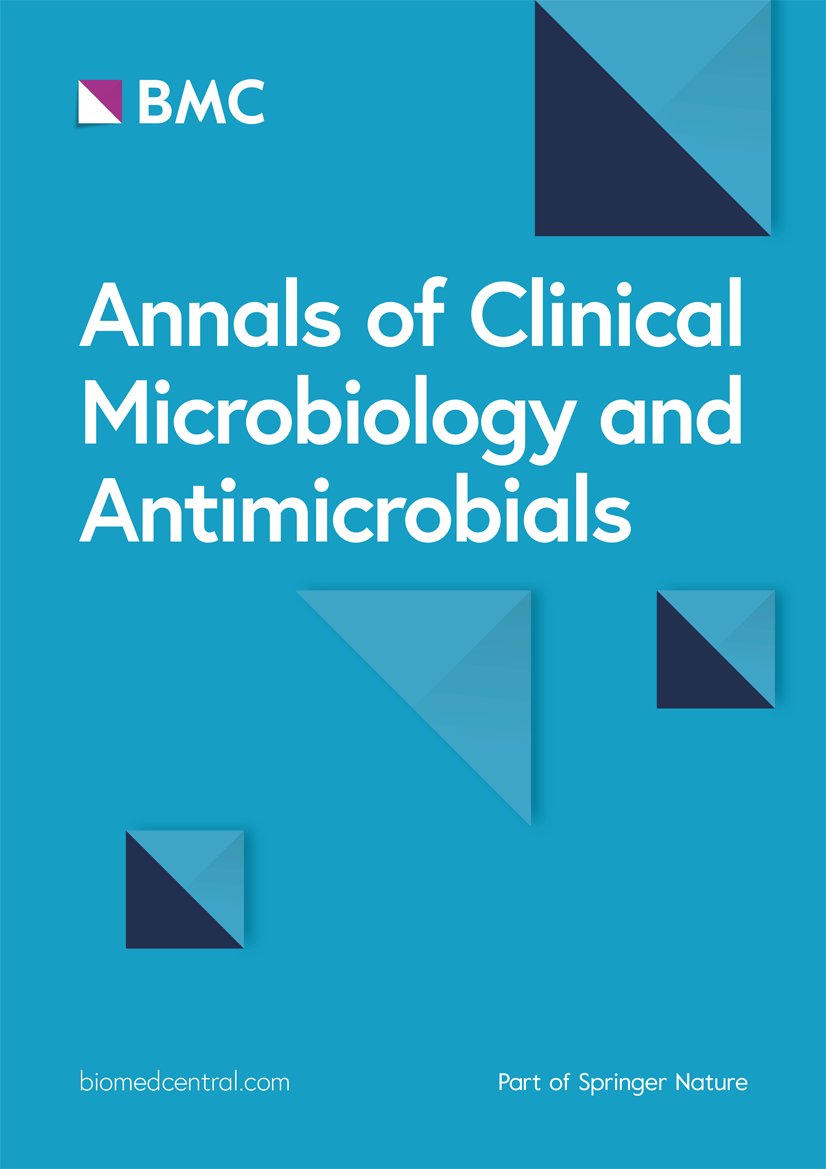Combination antimicrobial therapy: in vitro synergistic effect of anti-staphylococcal drug oxacillin with antimicrobial peptide nisin against Staphylococcus epidermidis clinical isolates and Staphylococcus aureus biofilms
IF 4.6
2区 医学
Q1 MICROBIOLOGY
Annals of Clinical Microbiology and Antimicrobials
Pub Date : 2024-01-20
DOI:10.1186/s12941-024-00667-6
引用次数: 0
Abstract
The ability of Staphylococcus epidermidis and S. aureus to form strong biofilm on plastic devices makes them the major pathogens associated with device-related infections (DRIs). Biofilm-embedded bacteria are more resistant to antibiotics, making biofilm infections very difficult to effectively treat. Here, we evaluate the in vitro activities of anti-staphylococcal drug oxacillin and antimicrobial peptide nisin, alone and in combination, against methicillin-resistant S. epidermidis (MRSE) clinical isolates and the methicillin-resistant S. aureus ATCC 43,300. The minimum inhibitory concentrations (MIC) and minimum biofilm eradication concentrations (MBEC) of oxacillin and nisin were determined using the microbroth dilution method. The anti-biofilm activities of oxacillin and nisin, alone or in combination, were evaluated. In addition, the effects of antimicrobial agents on the expression of icaA gene were examined by quantitative real-time PCR. MIC values for oxacillin and nisin ranged 4–8 µg/mL and 64–128 µg/mL, respectively. Oxacillin and nisin reduced biofilm biomass in all bacteria in a dose-dependent manner and this inhibitory effect was enhanced with combinatorial treatment. MBEC ranges for oxacillin and nisin were 2048–8192 µg/mL and 2048–4096 µg/mL, respectively. The addition of nisin significantly decreased the oxacillin MBECs from 8- to 32-fold in all bacteria. At the 1× MIC and 1/2× MIC, both oxacillin and nisin decreased significantly the expression of icaA gene in comparison with untreated control. When two antimicrobial agents were combined at 1/2× MIC concentration, the expression of icaA were significantly lower than when were used alone. Nisin/conventional oxacillin combination showed considerable anti-biofilm effects, including inhibition of biofilm formation, eradication of mature biofilm, and down-regulation of biofilm-related genes, proposing its applications for treating or preventing staphylococcal biofilm-associated infections, including device-related infections.联合抗菌疗法:抗葡萄球菌药物氧青霉素与抗菌肽尼生素对表皮葡萄球菌临床分离株和金黄色葡萄球菌生物膜的体外协同作用
表皮葡萄球菌和金黄色葡萄球菌能够在塑料设备上形成强大的生物膜,因此它们是与设备相关感染(DRIs)有关的主要病原体。生物膜嵌入的细菌对抗生素的耐药性更强,因此生物膜感染很难得到有效治疗。在此,我们评估了抗葡萄球菌药物奥沙西林和抗菌肽尼生素单独或联合使用对耐甲氧西林表皮葡萄球菌(MRSE)临床分离株和耐甲氧西林金黄色葡萄球菌 ATCC 43,300 株的体外活性。采用微流稀释法测定了奥沙西林和尼生素的最低抑菌浓度(MIC)和最低生物膜根除浓度(MBEC)。评估了奥沙西林和尼生素单独或联合使用的抗生物膜活性。此外,还通过实时定量 PCR 检测了抗菌剂对 icaA 基因表达的影响。奥沙西林和尼辛的 MIC 值分别为 4-8 µg/mL 和 64-128 µg/mL。奥沙西林和尼生素以剂量依赖的方式减少了所有细菌的生物膜生物量,并且这种抑制作用在组合处理中得到了增强。氧青霉素和尼生素的 MBEC 范围分别为 2048-8192 µg/mL 和 2048-4096 µg/mL。加入尼生素后,所有细菌的氧青霉素 MBECs 都明显降低了 8 到 32 倍。与未处理的对照组相比,在 1 倍 MIC 和 1/2 倍 MIC 浓度下,氧青霉素和尼生素都能明显降低 icaA 基因的表达。当两种抗菌剂以 1/2 倍 MIC 浓度混合使用时,icaA 基因的表达量明显低于单独使用时的表达量。Nisin/conventional oxacillin 复方制剂显示出相当大的抗生物膜作用,包括抑制生物膜的形成、消除成熟的生物膜以及下调生物膜相关基因,因此可用于治疗或预防葡萄球菌生物膜相关感染,包括器械相关感染。
本文章由计算机程序翻译,如有差异,请以英文原文为准。
求助全文
约1分钟内获得全文
求助全文
来源期刊

Annals of Clinical Microbiology and Antimicrobials
MICROBIOLOGY-
CiteScore
8.60
自引率
0.00%
发文量
49
审稿时长
>12 weeks
期刊介绍:
Annals of Clinical Microbiology and Antimicrobials considers good quality, novel and international research of more than regional relevance. Research must include epidemiological and/or clinical information about isolates, and the journal covers the clinical microbiology of bacteria, viruses and fungi, as well as antimicrobial treatment of infectious diseases.
Annals of Clinical Microbiology and Antimicrobials is an open access, peer-reviewed journal focusing on information concerning clinical microbiology, infectious diseases and antimicrobials. The management of infectious disease is dependent on correct diagnosis and appropriate antimicrobial treatment, and with this in mind, the journal aims to improve the communication between laboratory and clinical science in the field of clinical microbiology and antimicrobial treatment. Furthermore, the journal has no restrictions on space or access; this ensures that the journal can reach the widest possible audience.
 求助内容:
求助内容: 应助结果提醒方式:
应助结果提醒方式:


